List of National Trust properties in Somerset
.svg.png)
| 1. Barrington Court 2. Bath Assembly Rooms 3. Brean Down 4. Bruton Dovecote 5. Burrow Mump 6. Cadbury Camp 7. Cheddar Gorge 8. Clevedon Court 9. Coleridge Cottage 10. Crook Peak to Shute Shelve Hill 11. Dolebury Warren 12. Dovecot at Blackford Farm 13. Dunster Castle 14. Dunster Working Watermill 15. Ebbor Gorge 16. Fyne Court 17. Glastonbury Tor 18. Holnicote Estate |
19. King Alfred's Tower 20. King John's Hunting Lodge 21. Leigh Woods National Nature Reserve 22. Lytes Cary 23. Montacute House 24. Prior Park Landscape Garden 25. Sand Point and Middle Hope 26. Solsbury Hill 27. Stembridge Mill 28. Stoke sub Hamdon Priory 29. The Priest's House 30. Tintinhull Garden 31. Treasurer's House 32. Tyntesfield 33. Walton and Ivythorn Hills 34. Wellington Monument 35. West Pennard Court Barn 36. Yarn Market, Dunster |
The National Trust for Places of Historic Interest or Natural Beauty (informally known as the National Trust) owns or manages a range of properties in the ceremonial county of Somerset, England. These range from sites of Iron and Bronze Age occupations including Brean Down, Cadbury Camp[1] and Cheddar Gorge to Elizabethan and Victorian era mansions, which include examples such as Montacute House and Tyntesfield.[2] Some of the smaller properties include Coleridge Cottage and Stembridge Mill, the last remaining thatched windmill in England.[3]
Somerset consists of a non-metropolitan county, administered by Somerset County Council, which is divided into five districts, and two unitary authorities. The districts of Somerset are West Somerset, South Somerset, Taunton Deane, Mendip and Sedgemoor. North Somerset and Bath and North East Somerset historically came under Somerset County Council. In 1974 they became part of county of Avon, and in 1996 they became administratively independent when Avon was broken up into unitary authorities.[4]
Many of the buildings included in the list are listed buildings or scheduled monuments. Listed status refers to a building or other structure officially designated as being of special architectural, historical, or cultural significance; Grade I structures are those considered to be "buildings of exceptional interest".[5] Listing was begun by a provision in the Town and Country Planning Act 1947. A scheduled monument is a "nationally important" archaeological site or historic building, given protection against unauthorised change. Scheduled Monuments are specified in the Ancient Monuments and Archaeological Areas Act 1979, which defines a monument as:
Any building, structure or work above or below the surface of the land, any cave or excavation; any site comprising the remains of any such building, structure or work or any cave or excavation; and any site comprising or comprising the remains of any vehicle, vessel or aircraft or other movable structure or part thereof ...— (Section 61 (7)).[6]
Properties
| Site Name Alternative name(s) |
Constructed | Scheduling Number | Listed building grade | Location or parish | Image | Description |
|---|---|---|---|---|---|---|
| Barrington Court | 1550s | – | I[7] | Barrington 50°57′42″N 2°51′36″W / 50.9616°N 2.8599°W |
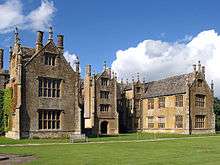 |
Barrington Court is a Tudor manor house begun around 1538 and completed in the late 1550s, with a vernacular 17th century stable court. After repair by Alfred Hoare Powell, it was the first house acquired by the National Trust, in 1907, on the recommendation of the antiquarian Canon Hardwicke Rawnsley.[8] In the 1920s the house was renovated, the stable block turned into a residence and several outbuildings, gardens and gateways constructed. The surrounding medieval deerpark and 17th century formal garden had largely disappeared until a new garden was laid out by Gertrude Jekyll in an Arts and Crafts-style in the first half of the 20th century.[9] |
| Bath Assembly Rooms | 1769–1771 | – | I[10] | Bath 51°23′12″N 2°21′49″W / 51.3866°N 2.3636°W |
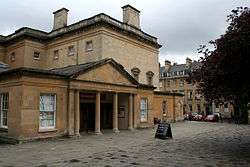 |
The Bath Assembly Rooms, designed by John Wood, the Younger, in 1769,[11] are a set of elegant assembly rooms located in the heart of the World Heritage City of Bath which are now open to the public. There are four main function rooms in the complex: the 100-foot-long (30 m) ballroom — the largest Georgian interior in Bath; the tea room; the card room; and the octagon.[12] |
| Brean Down | – | 1008211[13] | – | Mendip Hills 51°19′31″N 3°01′36″W / 51.3254°N 3.0266°W |
Brean Down is a promontory from the coast standing 320 feet (98 m) high and extending 1.5 miles (2 km) into the Bristol Channel at the eastern end of Bridgwater Bay between Weston-super-Mare and Burnham-on-Sea. Made of Carboniferous Limestone, it is a continuation of the Mendip Hills and has exposed steep cliffs. It is rich in wildlife, history and archaeology. It is a Site of Special Scientific Interest.[14] The earliest recorded settlement is from the Early to Middle Bronze Age. Brean Down Fort was built in 1865 as one of the Palmerston Forts to provide protection to the ports of the Bristol Channel.[15] The fort was decommissioned in 1901.[16] During World War II it was rearmed and used for experimental weapons testing. The site has been owned by the National Trust since 2002 after which they instituted a £431,000 renovation project.[17] | |
| Bruton Dovecote | 16th century | 50820[18] | II*[19] | Bruton 51°06′29″N 2°27′11″W / 51.1081°N 2.4531°W |
 |
The Bruton Dovecote was built in the 16th century. It was at one time used as a house, possibly as a watchtower and as a dovecote. The building was once within the deerpark of Bruton Abbey and was adapted by the monks from a gabled Tudor tower.[20] The conversion to be a dovecote took place around 1780.[21] It has over 200 pigeon holes.[22] The square tower was built of local stone with Doulting stone dressings. Although it is now a roofless ruin and some of the windows have been blocked up, it previously had a chimney and the fireplace can still be seen.[19] The National Trust acquired the freehold from Sir Henry Hugh Arthur Hoare of the Hoare baronets whose family seat was at Stourhead, in 1915.[23] |
| Burrow Mump | – | – | II*[24] | Burrowbridge 51°04′06″N 2°55′14″W / 51.0684°N 2.9205°W |
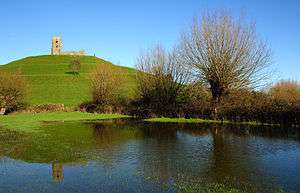 |
Burrow Mump is a hill and historic site overlooking Southlake Moor in the village of Burrowbridge. Burrow Mump is also known as St Michael's Borough or Tutteyate.[25] The hill and ruined roofless nave, with the remains of the porch and some window openings, were presented, in 1946, by Major Alexander Gould Barrett, to the National Trust and serve as a memorial to the 11,281 Somerset men who lost their lives during the first and second world wars.[26][27] |
| Cadbury Camp | – | 195367[28] | – | Tickenham 51°26′47″N 2°47′17″W / 51.4463°N 2.7880°W |
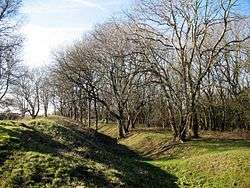 |
Cadbury Camp is an Iron Age hill fort.[29] Local legends associate it with Arthurian England and Camelot, though these may be due to confusion with the better-known Cadbury Castle, near South Cadbury, some 50 miles (80 km) to the south. The hill fort is well preserved, and is managed by the National Trust.[1] |
| Cheddar Gorge | – | – | – | Cheddar 51°16′58″N 2°46′00″W / 51.2829°N 2.7668°W |
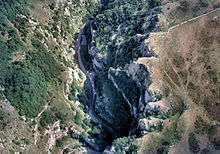 |
Cheddar Gorge is a limestone gorge in the Mendip Hills.[30] The gorge is the site of the Gough's Cave, where Britain's oldest complete human skeleton, Cheddar Man, estimated to be over 9,000 years old, was found in 1903.[31] Older remains from the Upper Late Palaeolithic era (12,000–13,000 years ago) have been found.[32] The caves, produced by the activity of an underground river, the Cheddar Yeo, contain stalactites and stalagmites. Cheddar Gorge, including the caves and other attractions, has become a tourist destination attracting about 500,000 visitors per year.[33] |
| Clevedon Court | 14th century | – | I[34] | Clevedon 51°26′27″N 2°50′01″W / 51.4407°N 2.8335°W |
.jpg) |
Clevedon Court is a manor house, dating from the early 14th century.[35] The great hall and chapel block are the earliest surviving parts of the structure with the west wing being added around 1570, when the windows and decoration of the rest of the building were changed. Further construction and adaptation was undertaken in the 18th century when it was owned by the Elton baronets.[36] The house was acquired by the nation and was given to the National Trust in part-payment for death duties in 1960. The Elton family is still resident in the house, which is now open to the public. In addition to the main house, the grounds include a selection of walls and outbuildings, some of which date back to the 13th century. The gardens are listed (Grade II*) on the Register of Historic Parks and Gardens of special historic interest in England.[37] |
| Coleridge Cottage | 17th century | – | II*[38] | Nether Stowey 51°09′08″N 3°09′13″W / 51.1521°N 3.1537°W |
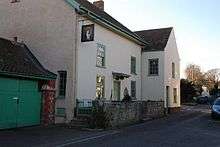 |
Coleridge Cottage is a cottage constructed in the 17th century. It contains a parlour, kitchen and service room on the ground floor and three bed chambers above.[39] The poet Samuel Taylor Coleridge lived at the cottage for three years from 1797 while writing This Lime-Tree Bower My Prison, The Rime of the Ancient Mariner, part of Christabel, and Frost at Midnight.[40] The cottage was refurbished in 1800. Having served for many years as 'Moore's Coleridge Cottage Inn',[41] the building was acquired for the nation in 1908, and the following year it was handed over to the National Trust.[42] In 2011 the Friends of Coleridge and the National Trust carried out redevelopment of the site.[43] |
| Crook Peak to Shute Shelve Hill | – | – | – | Mendip Hills 51°17′43″N 2°52′53″W / 51.2952°N 2.8814°W |
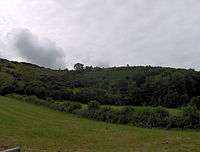 |
Crook Peak to Shute Shelve Hill is a 332.2 hectares (821 acres) geological and biological Site of Special Scientific Interest near the western end of the Mendip Hills, notified in 1952. Shute Shelve Hill, which is formed of Carboniferous Limestone laid down in the Lower Carboniferous period about 350 million years ago, rises to 233 metres (764 ft) above sea level.[44] The site extends for some 5 kilometres (3.1 mi) from west to east. This site comprises a wide range of habitats which includes ancient and secondary semi-natural broadleaved woodland, unimproved calcareous grassland and a complex mosaic of calcareous grassland and acidic dry dwarf-shrub heath. There are cave deposits of interest at the southern end of Crook Peak. Picken's Hole is of considerable importance because of its clear, well-stratified sequence of deposits and faunas, all dating from within the last Ice Age.[45] |
| Dolebury Warren | – | – | – | Churchill/Rowberrow 51°19′39″N 2°47′01″W / 51.32747°N 2.78358°W |
 |
Dolebury Warren is a 90.6 hectare biological Site of Special Scientific Interest (SSSI) near the villages of Churchill and Rowberrow in North Somerset, notified in 1952.[46] It is owned by the National Trust, who acquired the freehold in 1983 and managed by the Avon Wildlife Trust.[23][47] There is evidence of occupation of the site during the Iron Age and as a medieval/post medieval rabbit warren.[48] |
| Dovecot at Blackford Farm | 11th century | 1345406[49] | II*[49] | Selworthy 51°11′48″N 3°32′25″W / 51.1967°N 3.5403°W |
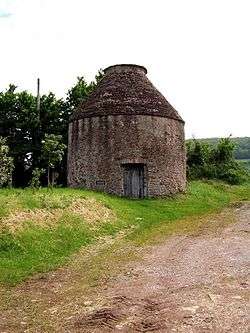 |
The Dovecot At Blackford Farm was built in the 11th century. It was attached to a mansion house which burnt down in 1875.[50] The dovecote which forms part of the property of the Holnicote Estate, was donated to the National Trust by Sir Richard Thomas Dyke Acland, 15th Baronet in 1944.[51] |
| Dunster Castle | 11th century | – | I[52] | Dunster 51°10′49″N 3°26′37″W / 51.1804°N 3.4437°W |
 |
Dunster Castle is a former motte-and-bailey castle, now a country house. The castle lies on the top of a steep hill called the Tor, which has been fortified since the late Anglo-Saxon period. After the Norman conquest of England in the 11th century, William de Mohun constructed a timber castle on the site as part of the pacification of Somerset. A stone shell keep was built on the motte by the start of the 12th century. At the end of the 14th century the de Mohuns sold the castle to the Luttrell family, who continued to occupy the property until the late 20th century.[53] The medieval castle walls were mostly destroyed following a siege at the end of the English Civil War. In the 1860s and 1870s, the architect Anthony Salvin was employed to remodel the castle to fit Victorian tastes. Following the death of Alexander Luttrell in 1944, the family was unable to afford the death duties on his estate and sold the castle and surrounding lands. The Luttrells bought back the castle in 1954, but in 1976 Colonel Walter Luttrell gave it and most of its contents to the National Trust.[54] |
| Dunster Working Watermill | c. 1780 | – | II[55] | Dunster 51°10′57″N 3°26′45″W / 51.1825°N 3.4459°W |
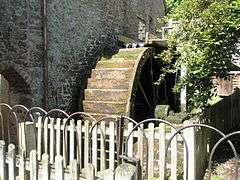 |
The Working Watermill (also known as Castle Mill) is a restored 18th century watermill, situated on the River Avill, in the grounds of Dunster Castle. The present mill, which was built around 1780, is on the site of a mill mentioned in the Domesday Book.[56] It was restored to working order in 1979. The mill is still used to grind wheat flour.[57] |
| Ebbor Gorge | – | – | – | Mendip Hills 51°14′02″N 2°40′55″W / 51.234°N 2.682°W |
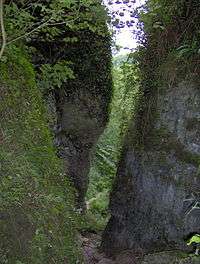 |
Ebbor Gorge is a limestone gorge in the Mendip Hills, close to Wells. It was designated as a 63.5-hectare (157-acre) biological Site of Special Scientific Interest in 1952. A 40-hectare (99-acre) area of the gorge is owned by the National Trust, and managed by Natural England as a National Nature Reserve.[58][59] There are three marked trails of varying lengths around the steeply wooded gorge. Various caves within the gorge were inhabited by neolithic people. The site is close to Wookey Hole village and caves and offers views across the Somerset Levels to Glastonbury Tor and beyond. The land was donated to the National Trust by Mrs G.W. Hodkinson in memory of Winston Churchill.[60] |
| Fyne Court | – | – | – | Broomfield 51°04′50″N 3°06′51″W / 51.0806°N 3.1143°W |
 |
Fyne Court is a nature reserve set in parkland which was originally the pleasure grounds of a large house belonging to pioneer 19th century electrician, Andrew Crosse, whose family had owned the house from its construction.[61] The house burnt down in 1898.[62][63] Fyne Court has been in the ownership of the National Trust since 1967 and was used as the headquarters of the Somerset Wildlife Trust.[64] The Quantock Hills Area of Outstanding Natural Beauty Service have their headquarters in the grounds. Much of the landscaping, including an arboretum laid out in 1780, has become overgrown and now provides varied habitats including broadleaved woodland, ponds and meadows grazed by highland cattle.[65] The site is home to over 100 species of fungi and some rare invertebrates.[64] |
| Glastonbury Tor | – | 196702[66] | – | Glastonbury 51°08′36″N 2°41′57″W / 51.1433°N 2.6992°W |
 |
Glastonbury Tor is a hill which features the roofless St. Michael's Tower.[67] The Tor has a striking location in the middle of a plain called the Summerland Meadows, part of the Somerset Levels. The plain is actually reclaimed fenland out of which the Tor once rose like an island but now is a peninsula washed on three sides by the River Brue. The remains of Glastonbury Lake Village nearby were identified in 1892, showing that there was an Iron Age settlement about 300–200 BC on what was an easily defended island in the fens.[68][69] Earthworks and Roman remains prove later occupation.[70] The spot seems to have been called Ynys yr Afalon (meaning "The Isle of Avalon") by the Britons, and it is believed by some to be the Avalon of Arthurian legend.[71] |
| Holnicote Estate | – | – | – | Exmoor 51°12′22″N 3°33′43″W / 51.206°N 3.562°W |
 |
The Holnicote Estate (/ˈhʌnɪˌkʌt/) is a property consisting of 5,026 hectares (12,420 acres) of Exmoor National Park situated in West Somerset. The property was donated to the National Trust in 1944 by Sir Richard Thomas Dyke Acland, 15th Baronet; it had been in the Acland family since 1745.[72] Holnicote Estate contains more than 240 kilometres (150 mi) of footpaths and bridleways. It includes Dunkery Beacon (part of which is Dunkery and Horner Wood National Nature Reserve) and Selworthy Beacon, and the villages and hamlets of Selworthy, Allerford, Bossington, Horner and Luccombe.[73] |
| King Alfred's Tower | 1772 | – | I[74] | Brewham 51°06′54″N 2°21′54″W / 51.115°N 2.365°W |
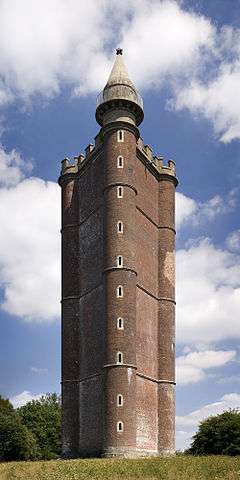 |
King Alfred's Tower or The Folly of King Alfred the Great was built as part of the Stourhead estate and landscape. The project to build the tower was conceived in 1762 by the banker Henry Hoare II (1705–1785).[75] The tower was also intended to commemorate the end of the Seven Years' War against France and the accession of King George III.[76] The tower was designed in 1765 by Henry Flitcroft and was completed in 1772 at an estimated cost of between £5,000 and £6,000. The tower is 49 metres (161 ft) high, and is triangular in plan, with round projections at each of the three corners.[74] |
| King John's Hunting Lodge | c. 1500 | – | II*[77] | Axbridge 51°17′14″N 2°49′07″W / 51.2872°N 2.8185°W |
 |
King John's Hunting Lodge is a wool-merchant's house of around 1500 in Axbridge. The building comprised shops on the ground floor, living areas and workshops on the first floor, and storage and sleeping areas on the second floor. It was saved from probable destruction thanks to a Miss Ripley, who bought it and bequeathed it to the National Trust, which undertook the works necessary to make it fit for visitors. In overhauling the structure of the premises in 1971, the National Trust restored its medieval character by recreating on the ground floor the appearance of arcaded stalls opening onto the street, and the sixteenth-century decoration of the upstairs windows.[78][79] The property is run as a local history museum by Axbridge and District Museum Trust with support from Somerset County Museums Service and Axbridge Archaeological and Local History Society.[80] |
| Leigh Woods National Nature Reserve | – | – | – | Long Ashton 51°27′47″N 2°38′21″W / 51.4631°N 2.6392°W |
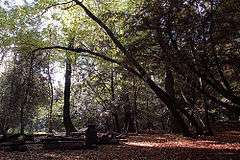 |
Leigh Woods is a 2 square kilometre (490 acre) area of woodland on the south-west side of the Avon Gorge, opposite the English city of Bristol and north of the Ashton Court estate. It is a National Nature Reserve.[81] Small mountain biking circuits are present in the woods and the area is a popular walking area for Bristolians. Part of the woodland was donated to the National Trust in 1909 by George Alfred Wills,[82] to prevent development of the city beside the gorge. Areas not owned by the National Trust have since been taken over by the Forestry Commission.[83] |
| Lytes Cary | 14th and 15th century | – | I[84] | Charlton Mackrell 51°02′09″N 2°40′04″W / 51.0358°N 2.6677°W |
 |
Lytes Cary is a manor house with associated chapel and gardens. The property has parts dating to the 14th century, with other sections dating to the 15th, 16th, 18th, and 20th centuries.[85] "Yet all parts blend to perfection with one another and with the gentle sunny landscape that surrounds them," comments Nikolaus Pevsner.[86] The chapel predates the existing house, and functioned as a chantry chapel, where masses could be said for the souls of the family, both living and dead. The gardens are listed as Grade II on the Register of Historic Parks and Gardens of special historic interest in England.[87] |
| Montacute House | 1598 | 1252021[88] | I[89] | Montacute 50°57′09″N 2°42′58″W / 50.9524°N 2.716°W |
Montacute House is a late Elizabethan country house, a textbook example of English architecture during a period that was moving from the medieval Gothic to the Renaissance Classical, and one of the finest houses to survive from the Elizabethan era.[90] It was visited by 119,590 people in 2011.[91] Designed by an unknown architect, the three-floored mansion, constructed of the local Ham Hill stone, was built in about 1598 by Sir Edward Phelips, Master of the Rolls; his descendants occupied the house until the early 20th century.[92] Following a brief period when the house was let to tenants, it was acquired by the National Trust in 1927. Since 1975, the mansion's Long Gallery, the longest in England, has served as a regional outpost of the National Portrait Gallery.[93] | |
| The Priest's House, Muchelney | 1308 | – | II[94] | Muchelney 51°01′16″N 2°48′55″W / 51.0211°N 2.8152°W |
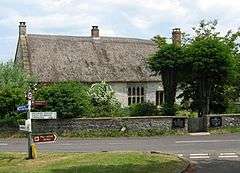 |
The Priest's House was built by Muchelney Abbey in 1308 for the parish priest[95] and incorporates a Gothic doorway, tracery windows and a 15th-century fireplace. The building was said to be "ruinous" in 1608. It was used by the vicar or curate until around 1840, when the house was used as a cellar and later as a school; in the late 19th century it was rented by a farmer. The building, which was acquired by the National Trust in 1911, is rented to a tenant who provides limited access to the public.[96][97] |
| Prior Park Landscape Garden | 18th century | 1004514[98][99] | I(Palladian bridge)[100] | Bath 51°22′02″N 2°20′37″W / 51.3672°N 2.3437°W |
 |
Prior Park Landscape Garden is an 18th-century landscape garden, designed by the poet Alexander Pope and the landscape gardener Capability Brown. It is south of Bath. The garden was influential in defining the style of garden known as the "English garden" in continental Europe. Prior Park was created by local entrepreneur and philanthropist Ralph Allen[101] from about 1734 until his death in 1764.[102] The 28 acre (113,000 m²) landscape garden is set in a site running down a small steep valley, with views of the city of Bath. Its many interesting features include a Palladian bridge (one of only 4 left in the world), Gothic temple, gravel cabinet, Mrs Allen's Grotto, and three lakes plus a serpentine lake.[103] |
| Sand Point and Middle Hope | – | – | – | Near Kewstoke 51°23′27″N 2°58′17″W / 51.3908°N 2.9715°W |
 |
Sand Point is the peninsula stretching out from Middle Hope, an 84.1 hectare biological and geological Site of Special Scientific Interest.[104] At Middle Hope a sequence of Carboniferous Limestone, and includes limestones, thick volcanic tufts and lavas are exposed. The site contains a Pleistocene aged fossil cliff and shore platform.[105] Among scarce plants found on Sand Point are Smallflower Buttercup, and Honewort. The calcareous grassland is dominated by Festuca species and Dactylis glomerata, while the scrub towards the west of the site is dominated by Hawthorn (Crataegus monogyna) and Blackthorn (Prunus spinosa), while that to the east consists of Common Gorse (Ulex europaeus) and Bramble (Rubus fruticosus agg).[105] |
| Solsbury Hill | – | – | – | Batheaston 51°24′36″N 2°20′03″W / 51.41°N 2.3342°W |
Little Solsbury Hill (more commonly known as Solsbury Hill) is a small flat-topped hill and the site of an Iron Age hill fort. It is located above the village of Batheaston. The hill rises to 625 feet (191 m)[106] above the River Avon which is just over 1 mile (2 km) to the south. It is within the Cotswolds Area of Outstanding Natural Beauty. It gives impressive views of the city of Bath and the surrounding area. It was acquired by the National Trust in 1930.[23] The hill was the inspiration for the 1977 song 'Solsbury Hill' by Peter Gabriel.[107] | |
| Stembridge Mill | 1822 | – | II*[108] | High Ham 51°04′35″N 2°49′13″W / 51.0765°N 2.8203°W |
Aug2006.jpg) |
Stembridge Tower Mill is the last remaining thatched windmill in England.[109][110] Stembridge Mill was constructed in 1822, including parts from the earlier Ham Mill which stood nearby,[111] with a 26 feet (7.9 m) high tower on an old mill mound.[112] It was damaged by storms and left running via steam by 1897/8 and last used commercially in 1910. In 1969 Professor H. H. Bellot left the windmill, cottage and garden to the National Trust in his will. The mill has four floors, a thatched cap and is constructed of local limestone known in the area as Blue Lias.[113] The mill is owned by The National Trust and underwent a £100,000 restoration by local craftsmen funded by the Grantscape Community Heritage Fund in 2009 and was re-opened later in the year.[114] |
| Stoke sub Hamdon Priory Parsonage Farm |
14th century | 1020665[115] | I[116] | Stoke-sub-Hamdon 50°57′16″N 2°44′56″W / 50.9545°N 2.7488°W |
_-_geograph.org.uk_-_897607.jpg) |
Stoke sub Hamdon Priory (which is also known as Parsonage Farm)[117] is a 14th-century former priest's house of the chantry chapel of St Nicholas.[118] The Ham stone building was originally the Provost's Lodging, part of the College Buildings of the Beauchamp Chantry. Before 1304 it may have been the rector's house. After 1518 it became a farm, known as Parsonage Farmhouse, which it remained until around 1960. The priory has been owned by the National Trust since 1946.[119] |
| Tintinhull Garden | early 20th century | – | I[120] | Tintinhull 50°58′28″N 2°42′26″W / 50.9744°N 2.7072°W |
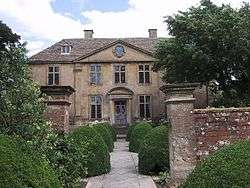 |
Tintinhull Garden is a small 20th century Arts and Crafts garden surrounding a 17th-century house. Tintinhull House was built of Hamstone, being reshaped in the early 18th century. The house was the property of the Napper family (who also owned Tintinhull Court) by 1630, and was passed down in the family until they sold it sometime after 1814.[120][121] The garden layout, with areas separated by walls and hedges, was developed in the early 20th century, and expanded and planted starting in 1933 by Phyllis Reiss in a "Hidcote" style. In 1954 Reiss gave the house and garden to the National Trust, but continued to live in the house and care for the garden until her death in 1961. From then on, the Trust let the house to a variety of tenants, including the garden designer and writer Penelope Hobhouse and her husband Professor John Malins from 1980 to 1993. The gardens are included in the Register of Historic Parks and Gardens of special historic interest in England and feature small pools and an azelea garden.[122] |
| Treasurer's House | 13th century | – | I[123] | Martock |  |
The Treasurer's House is a medieval priest's house built from Hamstone during the 13th century, with various extensions and alterations since. The Great Hall was completed in 1293 and there is an even earlier Solar Block with an interesting wall painting.[124] |
| Tyntesfield | 1860s | – | I[125] | Wraxall 51°26′25″N 2°42′49″W / 51.4403°N 2.7135°W |
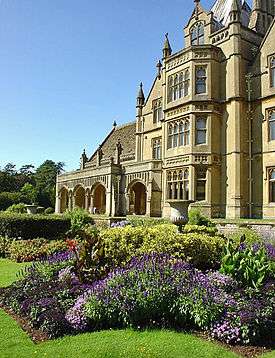 |
Tyntesfield is a Victorian Gothic Revival estate. It is named after the Tynte baronets who had owned estates in the area since around 1500. It was the site of a 16th-century hunting lodge which was used as a farmhouse until the early 19th century. In the 1830s a Georgian mansion was built on the site, which was bought by William Gibbs.[2] In the 1860s he had the house significantly expanded and remodelled, with a chapel being added in the 1870s. The Gibbs family owned the house until the death in 2001 of George Gibbs (known as Richard). The house was acquired by the National Trust in June 2002 after a fund raising campaign to prevent it being sold to private interests and ensure it be opened to the public. It was opened to visitors for the first time just 10 weeks after the acquisition. It was visited by 189,329 people in 2012, an 8.5% fall on the previous year.[126] |
| Walton and Ivythorn Hills | – | – | – | Street 51°06′30″N 2°45′05″W / 51.1083°N 2.7513°W |
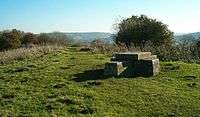 |
Walton and Ivythorn Hills is a 34.9 hectare (86.1 acre) biological Site of Special Scientific Interest near Walton and Street at the south-eastern end of the Polden Hills. The Trust acquired 0.248 hectares (0.61 acres) of Ivythorn Hill in 1988, which followed 16.606 hectares (41.03 acres) of Walton Hill in 1940 and the initial 18.751 hectares (46.33 acres) of Ivythorn Hill and Wood in 1919.[23] Walton and Ivythorn Hills support a complex mosaic of semi-natural habitats which includes unimproved calcareous grassland, dense and scattered scrub and broadleaved woodland. Structural diversity within the habitats, together with the extensive areas of sheltered wood-edge and scrub-edge margins, provide ideal conditions for many species of invertebrate. Butterflies, Leafhoppers, Spiders and Soldier Flies are particularly well represented.[127] |
| Wellington Monument | 1854 | – | II*[128] | Blackdown Hills 50°56′53″N 3°13′45″W / 50.948°N 3.2293°W |
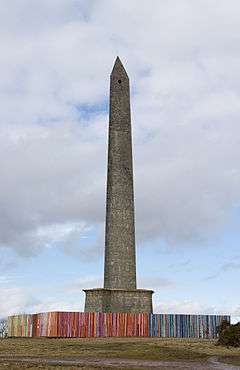 |
The Wellington Monument is a 175 feet (53 m) high triangular tower located on the highest point of the Blackdown Hills, 3 km (1.9 miles) south of Wellington. It was erected to celebrate the Duke of Wellington's victory at the Battle of Waterloo. The foundation stone was laid in 1817, on land belonging to the Duke, but the monument was not completed until 1854. Its design was inspired by an Egyptian obelisk, but in the shape of the type of bayonet used by Wellington's armies.[129] It is 80 feet (24 m) wide at the base. A counterweight hangs inside to help balance the Monument in windy weather. An internal staircase ascends to a viewing platform.[130] In June 2009, the National Trust announced plans to reclad the monument at a cost of £4 million.[131] |
| West Pennard Court Barn | 15th century | – | I[132] | West Bradley 51°07′51″N 2°38′56″W / 51.1308°N 2.6489°W |
 |
West Pennard Court Barn (which is also known as the Court Barn, West Bradley) is a 15th-century tithe barn for Glastonbury Abbey between West Pennard and West Bradley.[133][134] The barn was restored in the 1930s by the Society for the Protection of Ancient Buildings,[135] with the work being funded by Roger Clark of the local shoemakers C. & J. Clark.[136] It has been owned by the National Trust since 1938. The upper floor has an unusual floor made of compacted earth.[136] The rectangular five bay stone barn is supported by buttresses.[132] The roof was originally thatched but is now tiled.[136][137] |
| Yarn Market, Dunster | c. 1590 | – | I[138] | Dunster 51°11′04″N 3°26′39″W / 51.1845°N 3.4442°W |
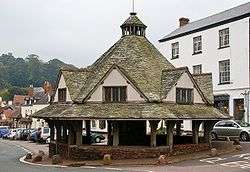 |
The Yarn Market was built around 1590. The octagonal structure has a central stone pier which supports a heavy timber framework which carries a slate roof with central wooden lantern surmounted by a weather vane. Around 1590 George Luttrell, of the Luttrell family constructed the market to shelter traders and their wares from the rain. One of the roof beams has a hole in it, a result of cannon fire in the Civil War, when Dunster Castle was a besieged Royalist stronghold.[139] Following the damage, it was restored in 1647 to its present condition. It is in the guardianship of English Heritage but is managed by the National Trust.[140] |
See also
References
- 1 2 "Cadbury Camp". National Trust. Retrieved 24 March 2013.
- 1 2 "Tyntesfield". National Trust. Retrieved 20 April 2013.
- ↑ "Somerset – a county of contrasts". National Trust. Retrieved 15 December 2013.
- ↑ "The Avon (Structural Change) Order 1995". HMSO. Retrieved 9 December 2007.
- ↑ "What is a listed building?". Manchester City Council. Retrieved 8 December 2007.
- ↑ Text of the Ancient Monuments and Archaeological Areas Act 1979 as in force today (including any amendments) within the United Kingdom, from legislation.gov.uk
- ↑ Historic England. "Barrington Court (1345920)". National Heritage List for England. Retrieved 17 March 2013.
- ↑ "Barrington Court Park, Barrington". Somerset Historic Environment Record. Somerset County Council. Retrieved 17 March 2013.
- ↑ "Barrington Court". National Trust. Retrieved 24 March 2013.
- ↑ "Assembly Rooms". Images of England. Historic England. Retrieved 5 November 2007.
- ↑ "Bath Assembly Rooms". National Trust. Retrieved 24 March 2013.
- ↑ "Ball Room". Bath's Historic Buildings. Bath and North East Somerset Council. Retrieved 13 May 2014.
- ↑ Historic England. "Brean Down (1008211)". National Heritage List for England. Retrieved 24 March 2013.
- ↑ "Brean Down" (PDF). English Nature. Retrieved 24 March 2008.
- ↑ "Brean Down". National Trust. Retrieved 24 March 2013.
- ↑ "Hillfort, Brean Down". Somerset Historic Environment Record. Somerset County Council. Retrieved 21 March 2011.
- ↑ "£431,000 revamp for historic fort". This is the West County. 20 June 2002. Retrieved 21 December 2013.
- ↑ "Dovecote, about 370 meters south of Bruton Church (also known as Pigeon Tower), Park Wall (North side), Bruton". Somerset Historic Environment Record. Somerset County Council. Retrieved 30 December 2013.
- 1 2 Historic England. "Dovecote about 370 metres South of Bruton Church (1056424)". National Heritage List for England. Retrieved 3 April 2015.
- ↑ Greeves, Lydia (2013). Houses of the National Trust. London: National Trust Books. p. 364. ISBN 978-1-907892-48-6.
- ↑ "Tower, S of the church, Bruton". Somerset Historic Environment Record. Somerset County Council. Retrieved 30 December 2013.
- ↑ "Bruton Dovecote". Somerset Routes. Retrieved 30 December 2013.
- 1 2 3 4 "Acquisitions Up to December 2011" (PDF). National Trust. Retrieved 21 December 2013.
- ↑ "Remains of Church on Burrow Mump". Images of England. Historic England. Retrieved 5 October 2010.
- ↑ "Burrow Mump". The Gatehouse. Retrieved 5 October 2010.
- ↑ Dunning, Robert (1983). A History of Somerset. p. 101. ISBN 0-85033-461-6.
- ↑ Leete-Hodge, Lornie (1985). Curiosities of Somerset. Bodmin: Bossiney Books. p. 82. ISBN 0-906456-98-3.
- ↑ "Cadbury Camp". National Monument Record. Historic England. Retrieved 22 March 2011.
- ↑ "The Iron Age past of Cadbury Camp". National Trust. Retrieved 21 December 2013.
- ↑ "Cheddar Gorge". National Trust. Retrieved 24 March 2013.
- ↑ "Tourist Hotspots — Cheddar Gorge". BBC. Retrieved 12 August 2007.
- ↑ "Cheddar Gorge". Somerset Historic Environment Record. Somerset County Council. 1983. Retrieved 12 August 2007.
- ↑ "Access Q&A: Cheddar Gorge". British Mountaineering Council. 1999. Retrieved 21 December 2013.
- ↑ "Clevedon Court". Images of England. Historic England. Retrieved 16 March 2008.
- ↑ "Clevedon Court". National Trust. Retrieved 24 March 2013.
- ↑ "Clevedon Court". Pastscape. English Heritage. Retrieved 13 May 2014.
- ↑ Historic England. "Clevedon Court (1000565)". National Heritage List for England. Retrieved 8 May 2013.
- ↑ "No 35 (Coleridge's Cottage) and No 37". Images of England. Historic England. Retrieved 16 November 2007.
- ↑ "Coleridge Cottage". Friends of Coleridge. Retrieved 21 December 2013.
- ↑ "Walk The Coleridge Way". BBC Somerset. Retrieved 12 February 2008.
- ↑ "Coleridge Cottage". National Trust. Retrieved 24 March 2013.
- ↑ "The Campaign to Acquire Coleridge Cottage". University of Alberta. Retrieved 16 November 2007.
- ↑ "Coleridge Cottage, Nether Stowey – National Trust". The Friends of Coleridge. Retrieved 13 May 2014.
- ↑ Haslett, Simon K. (2010). Somerset Landscapes: Geology and Landforms. Usk: Blackbarn Books. pp. 38–41. ISBN 978-1-4564-1631-7.
- ↑ "Crook Peak to Shute Shelve Hill" (PDF). English Nature. Retrieved 17 July 2006.
- ↑ "Dolebury Warren" (PDF). English Nature. Retrieved 13 May 2014.
- ↑ "Mendip Hills. Things to see and do". National Trust. Retrieved 21 December 2013.
- ↑ "Dolebury Camp". Pastscape. English Heritage. Retrieved 13 May 2014.
- 1 2 Historic England. "Dovecot at Blackford Farm (1345406)". National Heritage List for England. Retrieved 3 April 2015.
- ↑ "Dovecote, Blackford Farm". Exmoor Historic Environment Record. Exmoor National Park. Retrieved 10 April 2014.
- ↑ "Blackford Dovecote on the Holnicote Estate and the Exmoor National Park". Everything Exmoor. Retrieved 11 April 2014.
- ↑ Historic England. "Dunster Castle and gatehouse (1057643)". National Heritage List for England. Retrieved 24 March 2013.
- ↑ "Dunster Castle". National Trust. Retrieved 24 March 2013.
- ↑ Garnett, Oliver (2003). Dunster Castle, Somerset. National Trust. p. 47. ISBN 978-1-84359-049-1.
- ↑ "Castle Mill and attached gateway and gates". Images of England. Historic England. Retrieved 7 November 2007.
- ↑ "Dunster Working Watermill". National Trust. Retrieved 21 December 2013.
- ↑ "Dunster Water Mill". Dunster Water Mill. Retrieved 23 September 2011.
- ↑ "Ebbor Gorge NNR". Natural England. Retrieved 21 December 2013.
- ↑ "Things to see and do". National Trust. Retrieved 21 December 2013.
- ↑ Leete-Hodge, Lornie (1985). Curiosities of Somerset. Bodmin: Bossiney Books. p. 24. ISBN 0-906456-98-3.
- ↑ Bush, Robin (1994). Somerset: The Complete Guide. Wimborne, Dorset: Dovecote Press. p. 46. ISBN 1-874336-26-1.
- ↑ "Fyne Court". About Britain. Retrieved 21 December 2013.
- ↑ Waite, Vincent (1964). Portrait of the Quantocks. London: Robert Hale. p. 38. ISBN 0-7091-1158-4.
- 1 2 "Broomfield". Quantock Online. Retrieved 29 August 2011.
- ↑ "Fyne Court". National Trust. Retrieved 25 March 2013.
- ↑ "Earthworks Glastonbury Tor". National Monuments Record. Historic England. Retrieved 23 March 2011.
- ↑ "Glastonbury Tor". National Trust. Retrieved 25 March 2013.
- ↑ "Glastonbury Lake Village". Somerset Historic Environment Record. Retrieved 18 November 2007.
- ↑ Adkins, Lesley; Adkins, Roy (1992). A Field Guide to Somerset Archaeology. Wimborne: Dovecote Press. p. 70. ISBN 0-946159-94-7.
- ↑ Rahtz, Phillip; Watts, Lorna (2003). Glastonbury: Myth and Archaeology. Tempus Publishing. p. 71. ISBN 978-0-7524-2548-1.
- ↑ "Gerald of Wales". Sources of British History. Britannia. Retrieved 2 December 2013.
- ↑ "National Trust, Holnicote Estate". BBC. Retrieved 11 January 2012.
- ↑ "Holnicote Estate". National Trust. Retrieved 7 April 2013.
- 1 2 Historic England. "Alfred's Tower (1175610)". National Heritage List for England. Retrieved 21 December 2013.
- ↑ "Alfred's Tower". Images of England. English Heritage. Retrieved 1 April 2008.
- ↑ Holt, Jonathan (2007). Somerset Follies. Bath: Akeman Press. pp. 46–47. ISBN 978-0-9546138-7-7.
- ↑ "King John's Hunting Lodge". Images of England. Retrieved 9 May 2006.
- ↑ "King John's Hunting Lodge". Axbridge and District Museum. Retrieved 25 August 2006.
- ↑ Reid, Robert Douglas (1979). Some Buildings of Mendip. The Mendip Society. ISBN 0-905459-16-4.
- ↑ "King Johns Hunting Lodge". National Trust. Retrieved 7 April 2013.
- ↑ "Leigh Woods NNR". Natural England. Retrieved 21 December 2013.
- ↑ "Leigh Woods". National Trust. Retrieved 21 December 2013.
- ↑ "Leigh Woods". Avon Gorge and Downs Wildlife Project. Retrieved 13 May 2014.
- ↑ "Lytes Cary". Images of England. Historic England. Retrieved 28 April 2009.
- ↑ "Lytes Cary". National Trust. Retrieved 13 April 2013.
- ↑ Pevsner, 2003 pages 228–229
- ↑ "Lytes Cary, Somerton, England". Parks and Gardens UK. Association of Gardens Trusts and the University of York. Retrieved 9 June 2013.
- ↑ Historic England. "Montacute House (1252021)". National Heritage List for England. Retrieved 3 April 2015.
- ↑ "Montacute House". Images of England. Retrieved 5 November 2007.
- ↑ Nicolson, Nigel (1965). Great Houses of Britain. Hamlyn Publishing Group. p. 77. ISBN 0-586-05604-1.
- ↑ "Visits made in 2011". Association of Leading Visitor Attractions. Retrieved 7 March 2013.
- ↑ "Montacute House, The Borough (North side, off), Montacute". Somerset Historic Environment Record. Somerset County Council. Retrieved 7 November 2009.
- ↑ "Montacute House". National Trust. Retrieved 10 April 2013.
- ↑ "The Priest's house". Images of England. English Heritage. Retrieved 30 October 2007.
- ↑ "Priest's House". National Trust. Retrieved 13 April 2013.
- ↑ Ross, David. "Muchelney Priest's House". Britain Express. Retrieved 14 December 2013.
- ↑ "Priest's House, Muchelney". National Trust. Retrieved 14 December 2013.
- ↑ Historic England. "Palladian Bridge, Prior Park, Bath (1004514)". National Heritage List for England. Retrieved 3 April 2015.
- ↑ "List of Scheduled Ancient Monuments". Bath and North East Somerset Council. Retrieved 21 December 2013.
- ↑ "Palladian Bridge in grounds of Prior Park". Images of England. English Heritage. Retrieved 20 July 2009.
- ↑ "Prior Park Landscape Garden". National Trust. Retrieved 13 April 2013.
- ↑ Bond, James (1998). Somerset Parks and Gardens. Somerset Books. pp. 82–84. ISBN 978-0-86183-465-5.
- ↑ Historic England. "Prior Park (1000144)". National Heritage List for England. Retrieved 3 April 2015.
- ↑ "Sand Point and Middle Hope". National Trust. Retrieved 31 December 2013.
- 1 2 "Middle Hope" (PDF). SSSI citation sheet. English Nature. Retrieved 2008-10-31.
- ↑ Scott, Shane (1995). The hidden places of Somerset. Aldermaston: Travel Publishing Ltd. p. 16. ISBN 1-902007-01-8.
- ↑ "Solsbury HillbyPeter Gabriel". Songfacts. Retrieved 13 May 2014.
- ↑ "Stembridge Mill". Images of England. English Heritage. Retrieved 3 March 2008.
- ↑ Leete-Hodge, Lornie (1985). Curiosities of Somerset. Bodmin: Bossiney Books. p. 84. ISBN 0-906456-98-3.
- ↑ "Stembridge Tower Mill". National Trust. Retrieved 15 April 2013.
- ↑ Coulthard, Alfred J.; Watts, Martin (1978). Windmills of Somerset and the Men who Worked them. London: Research Publishing Co. pp. 49–51. ISBN 0-7050-0060-5.
- ↑ Warren, Derrick (2005). Curious Somerset. Stroud: Sutton Publishing. p. 68. ISBN 978-0-7509-4057-3.
- ↑ Robert Dunning (Editor) (2004). "High Ham". A History of the County of Somerset: Volume 8: The Poldens and the Levels. Institute of Historical Research. Retrieved 21 December 2013.
- ↑ "The National Trust Magazine". News (Autumn 2009): 11.
- ↑ Historic England. "Medieval secular college at Parsonage Farm (1020665)". National Heritage List for England. Retrieved 3 April 2015.
- ↑ "The Priory, or Parsonage Farmhouse". Images of England. English Heritage. Retrieved 11 November 2007.
- ↑ "The Priory, or Parsonage Farmhouse (formerly listed as The Priory or Parsonage Farmhouse (Ruined portion)), North Street (West side), Stoke sub Hamdon". Somerset Historic Environment Record. Somerset County Council. Retrieved 7 July 2009.
- ↑ "Stoke-sub-Hamdon Priory". National Trust. Retrieved 15 April 2013.
- ↑ "Stoke sub Hamdon Priory". National Trust. Retrieved 21 December 2013.
- 1 2 "Tintinhull House". Images of England. English Heritage. Retrieved 8 June 2009.
- ↑ "Tintinhull House Kitchen Garden". National Trust. Retrieved 21 December 2013.
- ↑ "Tintinhull Garden". National Trust. Retrieved 21 December 2013.
- ↑ "The Treasurer's House". Images of England. English Heritage. Retrieved 30 October 2007.
- ↑ "Treasurer's House". National Trust. Retrieved 21 December 2013.
- ↑ Historic England. "Tyntesfield House (1129053)". National Heritage List for England. Retrieved 3 April 2015.
- ↑ "Visits made in 2012". Association of Leading Visitor Attractions. Retrieved 7 April 2012.
- ↑ "Walton and Ivythorn Hills" (PDF). English Nature. Retrieved 21 August 2006.
- ↑ "Wellington Monument". National Heritage List for England. Historic England. Retrieved 21 December 2013.
- ↑ Leete-Hodge, Lornie (1985). Curiosities of Somerset. Bodmin: Bossiney Books. p. 67. ISBN 0-906456-98-3.
- ↑ Hurd, Douglas (2003). The Germans We Trusted: Stories Which Had to be Told. Lutterworth Press. p. 124. ISBN 978-0-7188-3034-2.
- ↑ "Wellington monument to cost £4 m". BBC News. BBC. 16 June 2009. Retrieved 21 December 2013.
- 1 2 Historic England. "Court Barn (1175792)". National Heritage List for England. Retrieved 3 April 2015.
- ↑ Siraut, M.C.; Thacker, A.T.; Williamson, Elizabeth (2006). Dunning, R. W., ed. "Parishes: West Bradley". A History of the County of Somerset: Volume 9: Glastonbury and Street. Institute of Historical Research. Retrieved 15 December 2013.
- ↑ Abrams, Lelsey (1991). The Archaeology and History of Glastonbury Abbey: Essays in Honour of the Ninetieth Birthday of C.A.Ralegh Radford. Boydell Press. pp. 79–87. ISBN 978-0-85115-284-4.
- ↑ "West Pennard Court Barn". Britain Express. Retrieved 15 December 2013.
- 1 2 3 "West Pennard Court Barn". National Trust. Retrieved 15 December 2013.
- ↑ "Court Barn, West Bradley". Ken's Great Barns. Retrieved 15 March 2014.
- ↑ Historic England. "Yarn Market (1173428)". National Heritage List for England. Retrieved 3 April 2015.
- ↑ "Brief History of Dunster". Dunster Tithe Barn. Retrieved 26 May 2009.
- ↑ "Yarn Market, High Street (West side), Dunster". Somerset Historic Environment Record. Somerset County Council. Retrieved 26 May 2009.
External links
![]() Media related to National Trust properties in Somerset at Wikimedia Commons
Media related to National Trust properties in Somerset at Wikimedia Commons